

During his years at the upper crossing, Captain Lane, as Aaron was known throughout much of his life in California, had ample opportunity to discover where the richest farmlands lie along the Mojave River. He thus far had grown crops on a small scale to feed his own stock and those of the travelers who stopped at his station, but the ever-increasing traffic on the Mojave Desert meant an opportunity for excellent profits if he could supply hay, barley and other crops in quantity.
There was also a profit to be made in marketing the grasses indigenous to the river. A variety of these grew luxuriantly in the lowland: bottom grass, blue joint, red top clover, and wire and salt grasses. On the benches along the overflow of the river, there was a proliferation of bunch, guyote and sand grasses. Many beefeaters swore that the cattle which fed on these grasses produced the best meat they had ever tasted.
LANE'S RANCH IN BRYMAN
The site Lane chose for his new home was a splendid one. He had shrewdly decided to turn his sights to agriculture, though he continued to raise livestock, and the land he had selected this time included the most fertile ground along the overflow of the river. Lane praised the superior quality of this soil in an article he wrote for the newspaper:
The land on the Mojave, at the point where I am, is exceedingly fertile, and comparatively free from alkali. It is of that peculiar character which retains moisture well, and consequently I am able to cultivate successfully without irrigation. I do irrigate my garden, this season, but planted in the proper time, it would not be necessary so to do. |
Lane described his ranch as being "immediately on the river, seven miles from the Upper Crossing," which today is in the community of Bryman. Though he did not mention it in the article, the ranch sat on a pretty stretch of land along the Mojave River. The surrounding landscape offers a view of the desert mountains and hills. Along the west side of the river a steep bank rises vertically some 200 feet high, and a dense forest of green cottonwoods and creek willows blankets the river bottom as far as the eye can see.
THE MOVE TO BRYMAN WAS WELL-TIMED
The timing of Lane's move was excellent on several counts. In the first instance, because of his early arrival he was able to claim some of the best land before word got out about the favorable farming conditions along the river. And the news did spread; in April 1867 it was reported that several parties had taken up land on the Mojave River, under the "swamp and overflowed land" act.
The report commented on the extensive farming along the river, stating that it would be good to have the land "settled up" with farms. By October of the same year, it was said that all the vacant land susceptible of tillage along the Mojave river had been taken up, although this was undoubtedly an exaggeration.
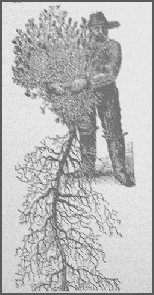 A. I. Root, ABC's of Bee Culture Extensive root system of alfalfa as portrayed in an 1889 seed catalogue |
Secondly, alfalfa had just been introduced in the area and Lane elected to raise the experimental plant, a decision that would prove to be quite lucrative. Historian Luther A. Ingersoll credits San Bernardino County as being the site of the first successful culture of the plant in the United States.
The word alfalfa itself has been traced to the Arabic alfacfacah, meaning "the best feed." Europeans, however, call the plant lucerne, which means "light" or "shine." Alfalfa is believed to have originated in Asia and is one of the oldest grasses known to man, but it was not until the winter of 1852-53 that it was introduced in San Bernardino.
John Metcalf, a colonist from Australia, brought some seed with him and experimented with it at his homestead on Mt. Vernon Avenue. The crop did well, and its cultivation soon was implemented in Los Angeles and then in Utah, where it became a major industry in that state. Alfalfa also became an important crop on the Mojave River and remains so to this day. It is often called "green gold," and so it proved to be for Lane and many others.
Thirdly, Lane's commercial crops benefited greatly from a period of excellent rainfall during the years 1867 and 1868. At harvest time in 1867, it was announced that immense crops of hay, barley and corn had been produced on the Mojave. Doubters were invited to "apply to Capt. A. G. Lane," who had his yards "crammed with crops."
Lane had purchased a mower at the end of May 1867 and set it to work. There was plenty of demand for the machine out in his neighborhood, as this was the first one on the river. Four years earlier, the Assessor's Office listed only three such mowers in the entire county.
Lane had planted a variety of crops in anticipation of an increasing demand, and his location and timing were perfect to take advantage of the growing commercial opportunities, some of which came from the military. Following the Civil War and up until 1870, the main supply route for the military in Arizona was the Mojave Road. The traffic over this route was of such proportions as to virtually insure the well-being of those desert residents who provided supplies. Soldiers regularly traveled the road, often in contingents of over 100, or even 200, men.
One period in early 1867 is of particular note, when two companies from the 8th Cavalry and two from the 14th Infantry were sent from San Francisco to the District of Prescott in Arizona, as a result of Indian problems. On March 10, 1867, Colonel John Irvin Gregg arrived at Camp Cady with the two companies, and the regimental headquarters, of the 8th Cavalry. Already present at the outpost was one company of the 14th Infantry, plus the Cady garrison; altogether there were more than 400 men and officers present, and in excess of 500 mules and horses.
Later that year the newspaper commented on the trade this traffic was producing, stating, "Teaming on the Mojave Road is brisk now. Mr. Matthews, the contractor for Camp Cady, is giving a good deal of employment, and buying barley extensively."
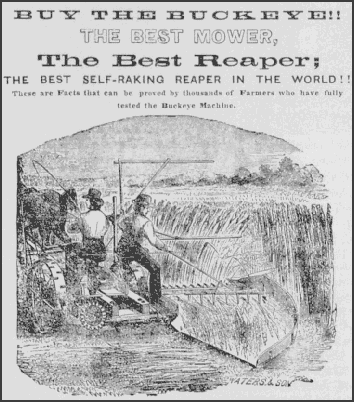
SOLDIERS MARAUD THE COUNTRYSIDE
Although the military was an excellent customer, bringing business to ranchers all along the Mojave River, the presence of so many troops was not entirely beneficial. There were bound to be some incidents of disorderliness with hundreds of soldiers traveling through the area, but during 1867 groups of infantrymen committed acts of theft and hooliganism throughout the countryside.
The first sign of trouble came in February, when the San Bernardino Guardian reported rumors of troops helping themselves to the property of private citizens:
TROOPS FOR ARIZONA -- On Monday last a portion of the troops destined for Arizona arrived here. They consisted of 75 men of company I, and 35 recruits for company H, 14th U. S. Infantry. They were under the command of Lt. S. M’Conihe. The men encamped about two miles east of the town. They left on Wednesday morning. Some people were busy circulating reports of depredations committed on the hen-roosts, lager and whiskey, while the soldiers were in the vicinity -- but we are sure they were guiltless of any kind of excess, for the reputation of the gallant 14th stands too high to be tarnished by the perpetration of such petty offenses. |
A few days later the paper reported sarcastically that yet more soldiers had "fully sustained the reputation of their gallant corps." At Martin’s Ranch in Cajon Pass they had fired into a flock of sheep, availing themselves of fresh mutton; at Armstrong’s they preferred chickens and whiskey, and at the quartermaster’s depot they selected blankets and sundry stores, paying for these with "fisticuffs and knock downs."
In August these crimes became more serious in nature when soldiers stationed at Camp Cady burned down the house of a civilian who lived nearby. The men claimed they had been cheated by this citizen; still, that did not excuse their behavior. Five soldiers were arrested by the sheriff, tried and convicted in Civil Court in San Bernardino, and sent to the penitentiary.
Quite a stir was raised in town when the judge released the commanding officer, Lieutenant Manuel Eyre, for lack of evidence. Some thought Eyre should be held responsible for the conduct of his men.
The arrests did not end the problem. The October 12, 1867, San Bernardino Guardian -- the same issue that reported the sentencing of the five soldiers -- carried a story about 200 troops of the 14th who had just passed through the county and had exhibited the same "peculiar" behavior at every stopping place.
The following week there were two more articles covering the same subject. The first told of another 600 troops who demonstrated the same disgraceful conduct as those who had preceded them, and reported that 46 soldiers deserted in one evening from the Cucamonga area, "amply provided for a sojourn in the mountains." The second article, by Guardian editor Henry Hamilton, shows just how serious the situation had become:
MORE OUTRAGES BY THE TROOPS -- We regret to be called on so frequently to notice the outrages of the military upon our citizens, as they march along to their destinations. Wherever soldiers now appear in a body, people prepare as for the force of an invading enemy. They drive off their stock, guards are placed in their houses, they watch all night to protect their property; and nothing intimidates these ruffians but the leveled rifles of the besieged. Surely the authorities could adopt some means to abate these outrages. The band of outlaws now passing through this county on the road to Fort Yuma, on their arrival at Temecula attacked the store of Mr. Szubinski, and helped themselves to its contents, dry-goods, clothing, boots and shoes, groceries -- everything, in fact, they took a fancy to. Fortunately, there was no liquor on the premises, and the cash had been secreted on the "defenders" making their appearance. To complete the outrage, they somehow succeeded in administering a drug to the Colonel of the command, which kept him quiet during the operation. |
Aaron Lane himself wrote a letter to the newspaper in December 1867 saying that a Mr. Strouse had been "knocked down and robbed by the boys at Camp Cady...." The year closed with another report that two companies of soldiers on their way to Fort Yuma had made themselves "very familiar" at the houses along the road; "...if they see what they want, they take it, and they very generally want everything they see."
Lane previously had let it be known that he would not put up with any such foolishness. The word had gone out, and the newspaper declared that this rowdy bunch better beware if they tried to bother Lane:
We guarantee that not one of Uncle Sam's brave boys will touch his hay, his cattle, or chickens. They didn't touch a single thing belonging to Uncle Billy Rubottom [in Cucamonga] though they laid bare the surrounding country. They don't like certain indications of a warm reception. |
In this brief account the Guardian editor merely reported what was obvious to anyone familiar with Lane's experiences on the desert: that Aaron Lane, as a nine-year veteran of the frontier, would protect himself and his property no matter what the source of trouble -- and there are no reports of these soldiers ever giving him problems during the entire year they wreaked havoc elsewhere in the county.
LANE'S RANCH BURNS DOWN
Lane maintained a good relationship with Camp Cady throughout this period, and his provisioning of the outpost was rapidly removing him from the ranks of the poor.

But just when things appeared to be brightest, the Captain's good fortune met with setbacks. The October 26, 1867, San Bernardino Guardian carried the news that his ranch had burned down:
There seems to be some fatality attending the houses along the Mojave river. We believe one at almost every station has been burned down. And now, Captain Lane's, the best house on the river, has shared the same fate. Our friend Meacham lost his house, and now Capt. Lane suffers. Two fires in succession in this locality are rather startling. |
The fire originated in a storehouse on Lane's property that was used by freighters for storage of their supplies, among which were several kegs of gunpowder. Five of the kegs exploded, and the resultant fire destroyed his home, his storage buildings, and everything inside them. Lane was away at the time, and when he returned he found nothing except smoldering ruins. The Captain began rebuilding immediately. In fact, in the same news story that reported the fire, it was announced that he was already prepared to supply travelers as before.
RANCH WASHED OUT BY FLOODS
No sooner did he recover from the fire, however, than his ranch was washed out by floods during a period of heavy rainstorms that began in December of 1867 and continued through January. As early as December 14th there was difficulty traversing the Mojave Road, and the mail stage was unable to get through Cajon Pass. Two weeks later the scope of the flooding, which was just becoming known, was reported in the press:
...continuous heavy rain has brought upon this locality a flood such as has not before visited us within the recollection of the present residents. Heretofore, the year 1862 was cited as the year of the flood; this year has outflooded that one. |
The rains were relentless. The newspapers became full of reports of rain-related disasters throughout the county. The Mojave Valley was inundated. Lane had built his house on a high rise of ground along the river bottom, and though the waters rose up all around him and his livestock ran off, his home was safe on an island. The editor of the Guardian commiserated with Captain Lane's circumstances, and then j okingly commented that Lane, stranded on his isle in the sea of water, was "master of Crusoe's situation, being monarch of all he surveyed."
In early January, after a delay of several days, the mail from Arizona finally succeeded in making the difficult passage through the Mojave. The mail expressmen reported that the wayside stations had been washed away, and noted that the "chances for entertainment" were not good. They said, however, that they believed "Captain Lane still holds forth."
The rain finally abated and Lane rounded up any stock he could find so he could resume ranching. Since he never wrote about any of these reversals, the extent of his losses is unknown. Though he may have lost his outbuildings and fences, his crops evidently benefited from the rich silt flooding over the property, as can seen by this advertisement that he ran in the Guardian from October 1867 clear through into March 1868:
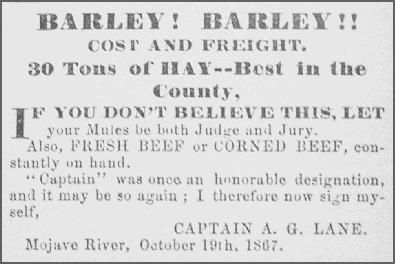
Lane announced his decision with this ad that he would begin calling himself "Captain" again, a title he had used previously but had dropped. Exactly how and when he assumed this honorific is unknown. He may have earned it during his years in Ione, for it was the practice of the miners to bestow military titles upon their leaders and organizers. Being called "Captain" would have appealed to Lane, since he preferred not to use his given name. However he came by it, during his years on the desert the title became associated with his Mexican War service, a misconception he may have fostered, or at least neglected to correct.

THE COURT-MARTIAL OF LT. MANUEL EYRE
Captain Lane continued to supply Camp Cady, but the transactions were not without problems. Lieutenant Manuel Eyre of Company K, 14th Infantry, had assumed command of the post in June of 1867. He also held the offices of Acting Commissary Subsistence (ACS), which had charge of purchasing food for the camp, and Acting Assistant Quartermaster (AAQM), which was responsible for obtaining all other provisions, and for providing all transportation, including that for food supplies. To the misfortune of the Lieutenant, he got into a dispute with some of the Mojave ranchers, and as a result eventually faced a court-martial because of accusations that he used questionable practices in his dealings with them.
One of the charges against Eyre was "Conduct to the prejudice of good order and military discipline." There were seven allegations under this heading, including one dealing with an official letter Eyre had written to Lane on January 31, 1868, in which he stated, "I would rather have your hay, than hay from a damned Mormon at $10.00 a ton cheaper."
Lane was called upon to testify at the trial, and he produced the letter in question. On examination, Eyre (who served as his own defense counsel) asked him, "Did I ever tell you the reason why I preferred your hay at $10 a ton more, than a Mormons?" Lane, who referred to Eyre in the third person, replied, "Because he was put out about the watering of the hay. He spoke about it. Some of the boys put rocks in it at the forks of the road and Watered the bales -- they fell short, they watered it to have it hold out." When asked if the "boys" referred to Mormons, Lane answered in the affirmative.
Lieutenant Eyre, who had been under arrest for eight months, and was informed of the specific charges only two days before the trial began, prepared a hastily written account of his side of events:
The first time I weighed hay in person the loads did not hold out, but when I came to give receipts to the teamsters, they stated that they had hitherto been allowed what they started with whereas by my weight they lost. After that I was always present at the weighing and the loads fell short sometimes as much as half a ton in a load of thirty hundred. Then they wet the bales and put stones in them and when I discovered it I "talked rough to them" to use the words of one who has appeared before the Court. At first they all wanted to shake hands and introduce each other to me but I did not shake hands as I knew nothing about them. This and other things made me enemies.... |
It was also alleged that Eyre was "Trafficking in certificates of Govt. indebtedness, to the prejudice of good order and military discipline." At times, when Camp Cady needed supplies but money was lacking, vouchers were issued by the ACS or AAQM. These were redeemable in San Francisco, but because of the trouble and delay in getting the money, the vouchers were often sold by their recipients at discount. The potential for abuse by the acquisitions officer is obvious.
In this case Eyre was charged with issuing a voucher to pay a private debt. He took a voucher made out to Richard Mathews, and used it to pay a bill owed to Charley Roe, who supplied spirits to the sutler's store at Camp Cady. Eyre credibly defended himself against this accusation, but there is one aspect of it that involved Lane, albeit somewhat peripherally. When Eyre made a purchase from Lane he attempted to pay with a voucher, but it was returned. That was when Eyre wrote the January letter to Lane explaining his position, which is given here in its entirety:
Camp Cady |
Lane still refused to accept vouchers,
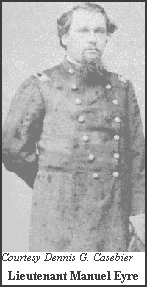 and was quoted by Eyre as having said he would "not receive Camp
Cady paper to peddle to the Jews." This is a reference to the
Jewish merchants in San Bernardino who were willing to redeem
the notes for fees of between six and eight percent. Eventually
Eyre agreed to send the vouchers to San Francisco and charge only
the express there and back, a proposition that was satisfactory
to Lane.
and was quoted by Eyre as having said he would "not receive Camp
Cady paper to peddle to the Jews." This is a reference to the
Jewish merchants in San Bernardino who were willing to redeem
the notes for fees of between six and eight percent. Eventually
Eyre agreed to send the vouchers to San Francisco and charge only
the express there and back, a proposition that was satisfactory
to Lane.
Referring to Captain Lane, Eyre said during the trial, "Now Camp Cady is supplied with good beef by this man at 11 [cents] per lb; when until I, by my act, produced in him confidence in Govt. vouchers, he would not have sold it at less than 13 [cents]; and there were no other bids even at that figure in the last contract."
According to abstracts of purchases and other documents, and testimony in the court-martial papers, one of the major suppliers to the post, other than Lane, was Richard Mathews. Mathews was named specifically as one whose load of hay was rejected by Eyre. Other suppliers included Daniel Cline; Charles Girard, who kept a station in Cajon Pass; William Armstrong; and William Lightfoot, one of the proprietors of the Cotton-woods Station.
Another accusation was that Eyre had sold two government mules to Lightfoot's partner, John J. Atkinson, for two inferior mules and $100 cash. Atkinson's testimony showed that instead he had traded two of his mules for two of the government’s that had "given out" at the Cottonwoods, and that Eyre had not been involved in the swap, nor was there an exchange of $100.
Eyre did approve the swap later, which he could hardly do otherwise, since Atkinson's mules were no longer on the desert. The two men evidently were friendly, because Atkinson testified that he had been "Wagon Master" at Camp Cady from the time of Eyre's arrival until early in 1868, and that they had "messed," or took meals, together for most of that time.
Lieutenant Eyre had definitely made himself some enemies on the desert. It appears that every charge possible was brought against him by some of the Mojave ranchers, no matter how insignificant.
In spite of the short time he had to prepare, Eyre gave an adequate defense against many of the allegations, but was unable to refute all of them. He was ultimately found guilty on several counts, and since he had previously alienated his fellow officers and had not developed the necessary support to protect himself from court-martial, he was dismissed from the service.
The accounts in the court-martial show that the Mojave ranchers were receiving payments running into several hundreds of dollars for their supplies to the military. They also show that Captain Lane was very competitive in his bids to Camp Cady, and was enjoying much of this prosperity.

A GLIMPSE OF LANE'S AFFABLE NATURE
By the summer of 1868, his prospects for further sales were looking very good. Grass was plentiful for grazing his stock, and his crops were flourishing. In August 1868, he wrote a lengthy letter to the Guardian in which he describes the 160 acres he had "taken up as a homestead":
There are one hundred acres well adapted to farming purposes. My place is well timbered, and I have as good water as there is in the world. I have command of grazing land sufficient for several head of stock. You can judge of the quality of the grass when I tell you that my horses and cattle keep fat the year round. I am supplying Camp Cady with beef, and the soldiers swear it is the best they ever ate. |
This correspondence consisted of 78 lines in the newspaper column, and the publication of such a long letter in a four-page weekly is proof that Lane's attraction to the press survived even after the Guardian was sold by his good friend, Henry Hamilton, who was both owner and editor. The paper was sold to two San Bernardino men, F. J. C. Margetson and Sydney P. Waite, on March 2, 1868, and the letter was written and published almost six months later. While it is true that much of Lane's coverage in newspapers was self-promotional, these editors and their successors obviously liked him, and there was a mutual benefit from his news "bulletins."
Even though the August correspondence to the Guardian is partly commercial, it is Aaron's only writing that offers such an intimate view of his affable nature. As can be seen from his letter, it is a peaceful day on the river, and Aaron is relaxing and enjoying a lull in activities:
All is quiet on the Mojave, and I write, not because I have any news of importance to communicate, but simply to gratify a propensity for scribbling, my mind having fallen into that particular mood this morning, immediately after indulging in that greatest of all luxuries -- a mint julep. What is better than a mint julep, especially on a hot day? And where is the man who can furnish better "stuff" to make it with, than Charlie Roe? Compounded of Roe's 40 year old French Brandy, Mojave water, loaf-sugar, and the proper proportion of mint, and it is not too much to say, that the "julep" is equal to the nectar of the gods. It is refreshing, cooling and healing; it drives away "dull care," gives one "spirit," sharpens the appetite, animates, invigorates, and it is a specific for the "blues." 'Twill chase away thy fear; 'Tis not so sweet as woman's lip, But, ah! 'tis more sincere. I told you in the opening paragraph that all was quiet on the river. There is but little travel, and "Lo the poor Indian" makes himself "mighty scarce" in this section of country. The principal freighting over the road at this time is done by the Government. Until within two weeks the weather has been quite pleasant, but we have had some "scorchers" during the last ten days, and we will probably have much hot weather between this and the 1st of October. |
It sounds as though the Captain is a very contented man. The Charlie Roe referred to here, and in the court-martial, was the owner of The Exchange, a liquor store in San Bernardino that advertised "Fine Cognac Brandies" among an assortment of other beverages. Lane closes his letter with this offer to his prospective guests:
In
conclusion, Messrs. Editors, allow me to give you an invitation to come
and see me. I can feast you upon wild game and fish, as well as
green corn and all sorts of vegetables, etc., etc. |
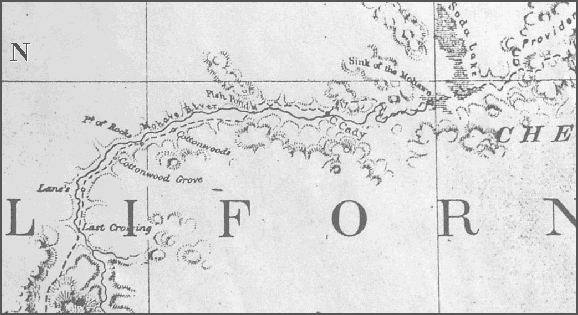

INDIANS SUBDUED AFTER BOLD ATTACKS
As Lane states, the Indians were making themselves "mighty scarce" at this time. Hostile activities on the desert had begun decreasing several months earlier, following two particularly difficult years of widespread attacks.
In 1866, the Indians, encouraged by a number of successes, had become bolder and bolder. In March of that year they killed three young cowboys in the area of present-day Summit Valley. In June one man was killed and another wounded as the result of two more attacks, one on a military express rider and his escort near Soda Lake, and another on a civilian wagon train at Marl Springs. The following month there was a battle between Camp Cady troops and a band of about 36 Indians, which ended with three soldiers dead and three wounded.
In January of 1867 a large band of Indians invaded the Lake Arrowhead area, burning a sawmill and some cabins. There were two encounters in which Indians were killed. The Indians were driven from the mountains by a citizen's militia and then pursued out into the desert, culminating in a fight at Rabbit Springs near what is now Lucerne Valley. The militia was headquartered at the upper narrows on the site of what would soon be the Brown Ranch. Later that year, in October of 1867, Indians attacked a mail wagon on the Mojave Road, and killed one of the three men in the party, an Army surgeon on his way to Fort Mojave.
There were a few at this time who recognized that many of the Indians' attacks were in defense of their land or in retribution for abusive or destructive behavior by the white man. Some were outraged by the systematic extermination of the Indians in the county and sympathized with their plight.
However, it would have been a rare occasion to hear these sentiments expressed by the beleaguered settlers on the desert. In fact, in this letter dated December 1, 1867, to the editor of the Guardian, it is made quite clear that some on the Mojave River were more of the opinion that, if anything, the Indians were being dealt with too leniently:
We want
Gen. Carlton, or some one like him, on this river, for three or
four weeks. He would hang some of these good Indians over the graves
of their victims, in a very short time. He would not keep an
Uncle Sam's hotel for Indians, at government expense. There is
too much of that kind of thing doing both here and in Arizona. |
It is evident by his letter that, like others, Lane felt animosity towards the Indians, which is not surprising, after nearly a decade of difficulties with them. The settlers did not have much longer to contend with hostile Indians. During 1868 the attacks subsided for the most part, although there was a murder in late March of 1869 in the vicinity of Cajon Pass. Following this incident, serious trouble with the Indians of the Mojave Desert ended.

LANE'S IS A PRINCIPAL RANCH ON THE MOJAVE
Even as late as 1871 the Mojave River was considered rather remote. One person took a trip to the mines at Ivanpah and thought it enough of an adventure into the wilderness to warrant writing a series of articles for the paper. In the September 9, 1871, Guardian, he writes of his stop at Lane's prospering way station and of Lane's good cheer and benevolence:
After crossing the river we struck a rolling sandy road running parallel with the river six or eight miles; we then reach Capt Lane's ranch; the hearty greeting of the old Capt (who had his title in the Mexican war) was refreshing; he has the good things of this life in abundance, and which he dispenses with a liberal hand to any unfortunates who may pass and there are a good many in this lower country who know from personal knowledge of the fact. The Capt has a nice garden growing on the banks of the river below his house with a good crop of corn, melons and vegetables generally. He has also about one hundred acres enclosed in a substantial fence which affords good pasture for his stock, consisting of horses, cattle and sheep. |
The fruitfulness of the Captain's garden was a wonderment to many of his guests over the years. One observer said that it had the best turnips he had ever seen, and a squash weighing over 100 pounds.
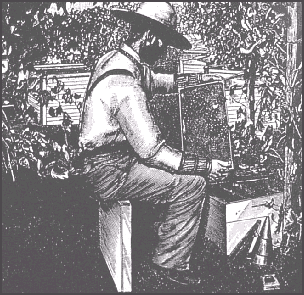
In December of 1873 Lane's Station was listed in the San Bernardino newspaper as one of the nine principal ranches on the Mojave River, along with Houlton's, Brown's, Kelley's, Atkinson's, Point of Rocks, Lightfoot's, Grape Vine, and Cady.
From the standpoint of acreage, these ranches were modest in size for the time, except for that of Amos Houlton, which at 920 acres was at least in the top 64 in San Bernardino County. There were nine ranches in the county that exceeded 10,000 acres. Former mountain man James W. Waters owned properties amounting to over 36,000 acres, which made his holdings almost feudal in proportion. Total acres assessed in 1873 were 370,880, at a value of $679,001 -- an average of $1.83 per acre.
SELLS RANCH, MOVES UPSTREAM
This December newspaper article was actually out of date; in early November, Lane had sold his ranch to William Blake, a businessman from Spadra, and the paper had carried the news of the sale:
SOLD OUT -- Capt. Lane sold to Phillips & Blake of Spadra, his nice little ranch on the Mojave River for the sum of ten thousand dollars. See what a little see-aheaditiveness will accomplish. Ten years ago the Captain landed on the banks of that fertile stream a poor man, penniless; to-day he has a little fortune. |
So Captain Lane, through hard work and resolve following his financial ruin sixteen years earlier in Ione, had now attained a position of solid middle class.
Following the sale of his ranch to Blake, the Captain decided to take a break and return to New England to see his family one last time. On February 14, 1874, the Guardian announced that "our old and esteemed friend, Capt. A. G. Lane, will leave in a day or two for the East on a visit to his old home...." Aaron told the editor of the paper that he had not been back East since he crossed the Isthmus of Panama in 1850.
After an absence of a few months, he returned to the same area of the desert and acquired a new ranch, about a mile south of the one he sold to Blake. This spread consisted of 240 acres, comprising the southeast quarter of section 36 (160 acres), T. 7 N., R. 5 W., plus an adjacent 80 acres in the southwest quarter. In addition, he had a possessory claim on another 400 acres abutting the Section 36 property on the west, which was fully enclosed with a fence and used as pastureland for stock. Besides this ranch, Aaron later had various property holdings on the desert. He owned a house in Oro Grande, and he had other properties that he bought and sold for speculation.
Aaron might very well have retired after his return to the Mojave, and simply enjoyed overseeing the work on his new property. He could afford it, and he definitely had earned the privilege. However, he was not one to idle away his remaining years complacently on his ranch. Instead he turned his energies to other ventures -- and with great exuberance, if the newspaper accounts are any indication.

 PAGE
1|
2|
3|
4|
5|
6|
7|
8|
9|
10|
11|
12
PAGE
1|
2|
3|
4|
5|
6|
7|
8|
9|
10|
11|
12

